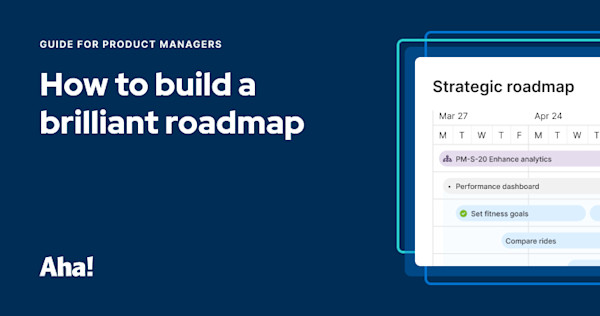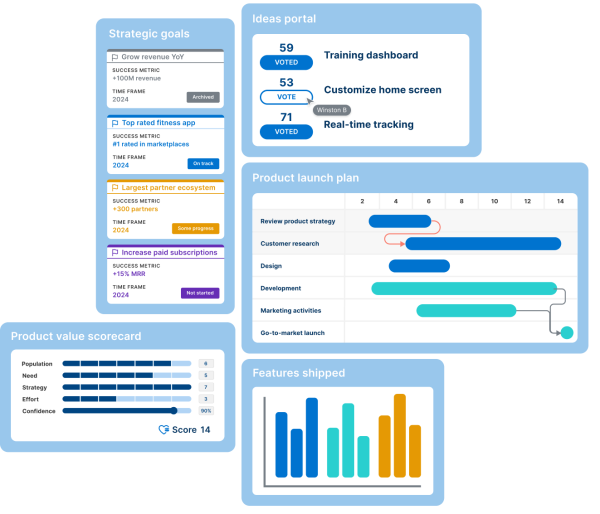What is a marketing roadmap?
Last updated: March 2025
You defined your marketing strategy. What comes next? You need a clear plan for what will get done and when. In short, you need a marketing roadmap.
A marketing roadmap helps you communicate your strategic direction and align cross-functional teams around a shared plan. Use it to clarify top priorities, set expectations, and keep teams focused on delivering meaningful results.
Connecting high-level business goals to the day-to-day work required to achieve them is not always easy. Without a structured process, marketing activities can become disjointed, making it harder to track progress and demonstrate impact. This is where a marketing roadmap becomes invaluable. These roadmaps visually map out how marketing activities contribute to broader company objectives.
In the past, teams relied on spreadsheets and slide decks to create marketing roadmaps. While familiar, these tools were not built for strategic planning. They make it difficult to connect strategy to real work and share updates across teams. Today's marketing teams have access to purpose-built roadmap software. With a tool like Aha! Roadmaps, you can define strategy, build dynamic roadmaps, and adjust plans as priorities evolve — all in one place.
Build your own roadmap in Aha! Roadmaps. Sign up for a free trial.
Let's explore everything you need to know about marketing roadmaps. Use the following links to jump ahead to a specific section:
Benefits of a marketing roadmap
Marketing roadmaps visually capture and communicate strategic plans. Although each roadmap serves a different purpose depending on the audience, the benefits remain the same:
Alignment: Rally the team around the “why” of your marketing strategy and the work required to achieve it.
Coordination: Build marketing roadmaps for each team function, program, or customer segment to ensure teams stay in sync.
Visibility: Keep the entire organization informed of when the next marketing campaigns and product launches are happening.
Impact: Track progress and demonstrate marketing's contribution to business objectives.
Communication: Keep teams aligned on marketing's direction and progress, ensuring leadership and stakeholders stay informed.
A roadmap sets clear expectations for what you will deliver. This encourages thoughtful decision-making about what you will commit to. When each work item aligns with your strategic objectives, you can be confident that your team's time is well spent.
Related:
How to create a marketing roadmap
Building a marketing roadmap is a collaborative effort. Start by reviewing the company's overall business objectives and identify where marketing can provide the most impact. Meet with stakeholders across the organization to understand their priorities and gather input. This upfront work will help you build a roadmap that aligns with cross-functional efforts.
Next, identify your audience so you can tailor what to include on your roadmap. Consider how folks will use the information you share and which elements will best communicate your message. Then, you can create different types of roadmaps to support a wide range of needs.
We suggest using purpose-built roadmapping software to capture strategic planning information in one place and keep it up to date. For example, Aha! Roadmaps offers whiteboard and note templates to help marketing teams quickly define strategy and create roadmaps. Want to try it yourself? Customize the strategic roadmap template below to suit your needs.

Audiences for a marketing roadmap
Many teams across your organization can benefit from greater visibility into your marketing plans. But each team will have a different focus and interest based on how your marketing plans impact their work.
Here are a few of the common audiences for a marketing roadmap (listed in alphabetical order):
Customer support teams | Support teams that interact directly with customers want to know what marketing messages are being shared so they can anticipate customers' responses. For example, an email campaign might generate a surge in support tickets. Sharing a marketing roadmap that includes activities with the potential to spark customer outreach will help these teams prepare accordingly. |
Executive leadership | Executives want to see how marketing programs and campaigns roll up to the corporate strategy. Presenting planned initiatives in the context of strategic goals helps demonstrate marketings impact on the business. |
IT and development teams | IT teams need to stay informed about marketing initiatives that may affect technology infrastructure. For example, if you plan to implement a new marketing automation system, a roadmap helps coordinate the timeline with IT to ensure a smooth rollout. |
Marketing teams | The entire marketing team benefits from an integrated plan that shows what you want to accomplish and when. Visualizing upcoming marketing activities on a roadmap improves collaboration and focuses the team on the work required to achieve your strategic goals. |
Product teams | Product and marketing teams need to work closely together to drive product success through effective launches. Building a go-to-market roadmap is an effective way to coordinate the timing of marketing campaigns with product launches so you can maximize promotional opportunities. |
Sales teams | Sales teams rely on marketing for timely updates on campaigns, events, and new sales enablement materials. A roadmap provides visibility into key activities—such as webinars, trade shows, or the release of updated competitor analysis and success stories. |
Related:
Components of a marketing roadmap
Once you have defined your audience, the next step is to consider the information you want to present. At a high level, a roadmap provides a visual overview of your plans on a timeline. But there are many different elements you can include depending on who the roadmap is for and how it will be used. Here are the key components that are commonly included in marketing roadmaps:
Time frame | Roadmaps typically include dates to show when program and campaign activities will be completed. Choose the time frame (such as days, weeks, months, or quarters) depending on the level of detail you need to share. |
Goals | Goals are measurable, time-bound objectives. Display your marketing goals on a roadmap to show what you want to achieve and the criteria for success. |
Initiatives | Initiatives are high-level themes of work that provide more context into what you will do to achieve your goals. For example, to increase leads within a specific customer use case, you might create an initiative to write a series of related case studies. |
Schedules | Visualize your major programs, campaigns, and events on a roadmap to communicate what is happening and when. |
Activities | Marketing activities represent discrete units of work that are required to deliver your plans. Include activities on your roadmap — such as landing pages, press releases, or sales tools — to provide more details about what is coming. |
Status | Status indicators for goals, initiatives, plans, and activities are a useful way to show how the team is progressing a |
8 marketing roadmap examples
If you are new to building marketing roadmaps, it is important to remember that there is no universal marketing roadmap template. You can use different types of roadmaps to deliver a tailored message to your audience. So what matters is creating a visual representation of your marketing plans in a way that captures and communicates your overall direction.
Let's cover eight different types below:
Strategy roadmap
A strategy roadmap shows how strategic marketing initiatives tie to your overall goals. This type of roadmap is useful when you need to show leadership or board members how your marketing initiatives and programs contribute to the company's objectives.

Your team can create strategic marketing roadmaps like this one in Aha! Roadmaps. Here, you can see product marketing initiatives mapped out across a specific time frame. This makes it easier to track major themes of work.
Portfolio roadmap
A portfolio roadmap is a useful way to align plans across different marketing functions — such as digital, content, and product marketing. Creating an integrated view of your marketing programs shows how you are progressing against your initiatives and keeps the team moving in the same direction.
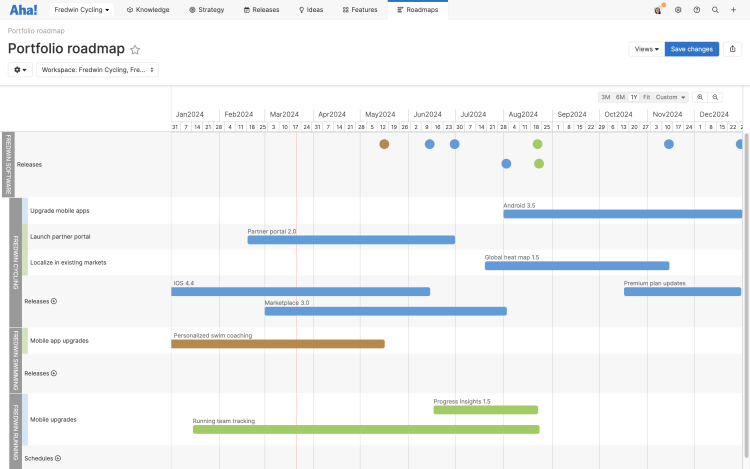
This portfolio roadmap in Aha! Roadmaps shows initiatives and associated activities across multiple products. You can easily tailor this view to show marketing programs instead of a product portfolio.
Integrated marketing roadmap
An integrated marketing roadmap helps teams coordinate efforts across different channels — such as content, digital, and product marketing — into a unified plan. It aligns messaging and connects marketing initiatives to broader business goals.

This custom roadmap created in Aha! Roadmaps ties cross-channel marketing efforts back to their initiatives. It also shows the various marketing teams responsible for carrying them out.
Activities roadmap
Build out a roadmap of planned work activities. This will keep cross-functional teams — such as sales and support — informed about exactly what is coming and when. You can show when the next campaigns and product launches are happening and provide specific details about new marketing assets that will be delivered.
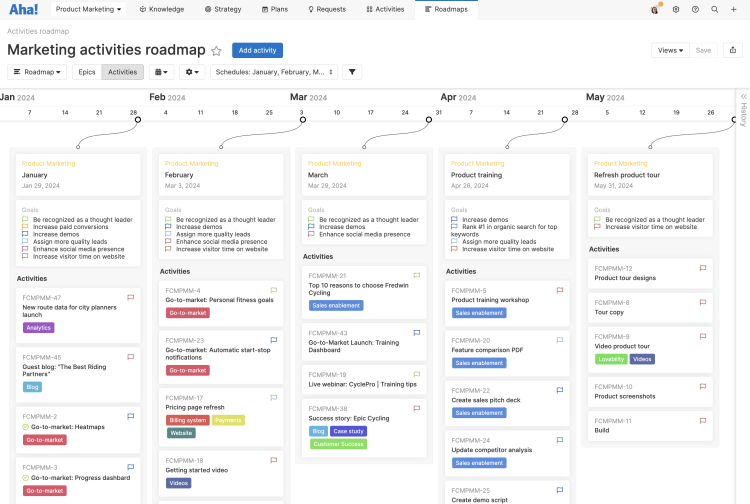
This view in Aha! Roadmaps quickly showcases the details of a marketing team's work over a few months — with a focus on goals and related activities.
Content marketing roadmap
A content marketing roadmap helps you plan and track content creation in alignment with your marketing strategy. It provides visibility into what will be produced, when it will go live, and how it supports broader initiatives.
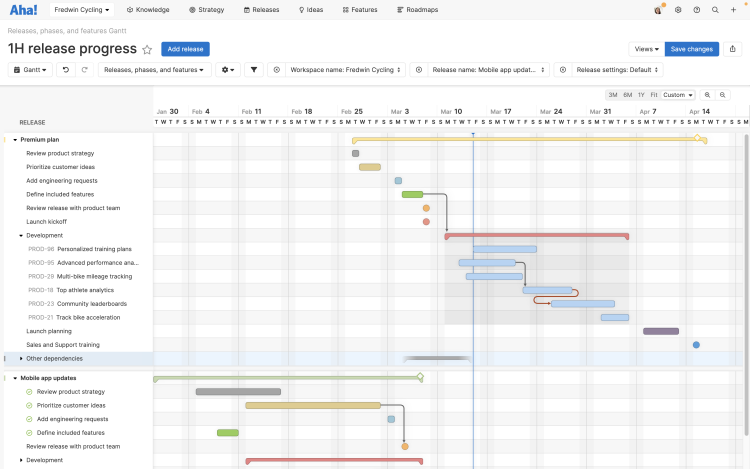
This is an example of a roadmap built in Aha! showing major releases over the first half of the year. You can make a similar roadmap for content marketing work in Aha! software.
Digital marketing roadmap
A digital marketing roadmap helps you plan and coordinate online marketing efforts — such as SEO, paid campaigns, social media, and website updates. It ensures all digital activities align with broader marketing goals and drive measurable impact.
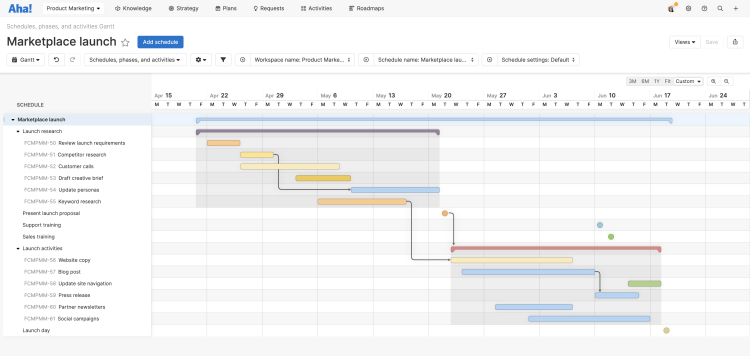
In Aha! Roadmaps, you can visualize your digital marketing strategy using Gantt charts to track schedules, dependencies, and key milestones.
Go-to-market roadmap
A go-to-market roadmap is a visual representation of the work you want to accomplish for your launch and the timeline for when you will get there. The purpose of a go-to-market roadmap is to capture and coordinate the timing of all the cross-functional activities required to release a new customer experience.
Launching something new is a big endeavor. If you are unsure where to start, draft a rough plan first. We suggest using a template that helps you work backward — define your launch goals first, then map the key milestones needed to reach them. Once you outline all of this, refine the details in your roadmap.
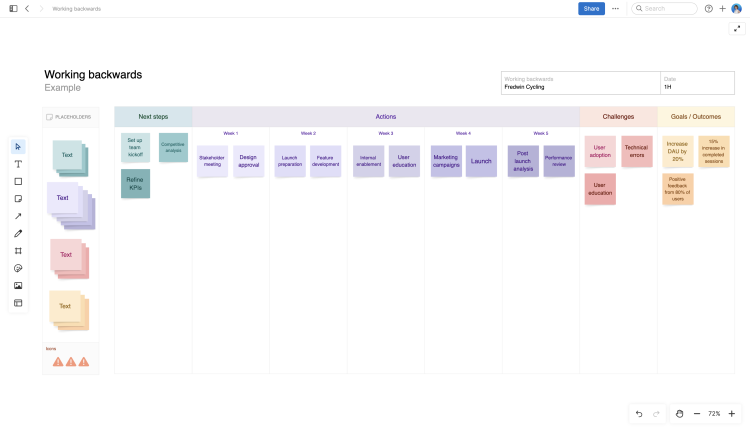
Custom roadmap
Need something even more tailored to your marketing department's needs? Marketing roadmaps can be customized to support a wide variety of use cases. For example, you can create a roadmap to show how your marketing plans support different customer segments or products.
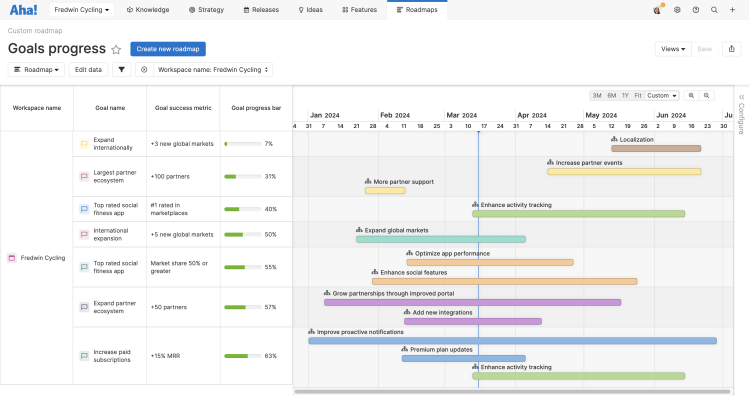
Custom roadmaps like this one — which features goals, success metrics, and associated initiatives — are easy to create in Aha! Roadmaps.
Related templates:
Marketing roadmaps are the best way to create a long-term view of how you will promote your product or service to reach the right customers. This aligns the entire organization around what you want to achieve — so you can focus on delivering the right programs and campaigns to get there.
Ready to start building your own marketing roadmap template? Aha! software has options — from marketing roadmap templates on whiteboards to customizable, robust roadmaps that generate based on work you have in progress. Browse our template library or sign up for a free 30-day trial to get the team aligned.
FAQs about marketing roadmaps
A marketing strategy captures what your marketing team will do to support the wider company's success. To create the marketing strategy, marketing leadership (e.g., the CMO and VP of marketing) typically connects with company leaders to understand where marketing can make an impact. From there, marketing leaders will work with the marketing team to define goals, initiatives, target markets, and more in order to achieve this impact.
This process can vary depending on your organization. But in general, you should create your marketing strategy before you build the marketing roadmap and your team starts tackling any work. What you include in your marketing strategy will also shift according to your specific needs, but we have outlined some common components in this guide covering the basics of marketing strategies.
If you need a boost to get started on your marketing strategy, purpose-built planning tools such as Aha! software can help. It comes with pre-built creative brief, positioning, and persona templates.
Much like a general marketing roadmap, a digital marketing roadmap shows goals, initiatives, and activities on a timeline — just on a smaller scale. It displays strategy and work specific to the digital marketing team as well as how these efforts help the broader marketing department reach its overall goals (and by extension, company goals).
For example, let's say your digital marketing team has a goal to launch a new paid media campaign this quarter. Your digital marketing roadmap will showcase planned major initiatives, activities, and milestones over the next three months that will help achieve this goal. This could include things like publishing paid landing pages or testing advertisements across social platforms. This provides another layer of visibility into the digital marketing team's work, whereas a general marketing roadmap will show work across multiple functional groups.
The exact details and information you include will depend on who is viewing your digital marketing roadmap. In general, your audience should be able to tell how the team is progressing against goals and how digital marketing work ties back to the overall marketing strategy by looking at this roadmap.
The best marketing roadmaps provide visibility between cross-functional marketing groups and the rest of the organization — outlining what the marketing team is doing to reach its goals and contribute to the company. By making this information transparent on a timeline, a good marketing roadmap can help everyone understand the "why" behind their tasks, how each of their projects contribute to marketing's success, and the team's overall progress against the marketing strategy.
A good marketing roadmap is also tailored to your stakeholders. Ask yourself: What information is relevant to my audience? What progress updates do they care about? Use this to inform what you show on your marketing roadmap to have the biggest impact.
Meanwhile, a bad marketing roadmap comes with more questions than answers. If key details are missing or no longer current, then your team and leadership might start wondering about progress. This is also true if it is unclear how your marketing roadmap supports your strategy. Make sure that you can provide a clear link between anything on your roadmap and the goals you want to achieve. If not, your roadmap needs some work.
